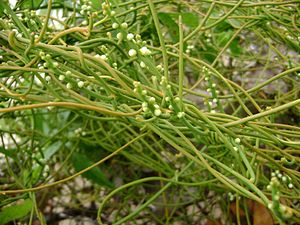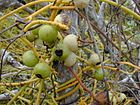Note: This is a project under development. The articles on this wiki are just being initiated and broadly incomplete. You can Help creating new pages.
Difference between revisions of "Cassytha filiformis - Akashavalli"
(→References) |
(→Uses) |
||
| Line 3: | Line 3: | ||
==Uses== | ==Uses== | ||
| − | {{Uses|Dysentery}}, {{Uses|Skin diseases}}, {{Uses|Hair | + | {{Uses|Dysentery}}, {{Uses|Skin diseases}}, {{Uses|Hair problems}}, {{Uses|Dairrhea}} |
<ref name="Uses"/> | <ref name="Uses"/> | ||
Revision as of 11:48, 6 September 2019
'Akashavalliis leafless parasitic climbing twiner, that can be seen growing in South India in very dry gravelly localities.
Contents
- 1 Uses
- 2 Parts Used
- 3 Chemical Composition
- 4 Common names
- 5 Properties
- 6 Habit
- 7 Identification
- 8 List of Ayurvedic medicine in which the herb is used
- 9 Where to get the saplings
- 10 Mode of Propagation
- 11 How to plant/cultivate
- 12 Commonly seen growing in areas
- 13 Photo Gallery
- 14 References
- 15 External Links
Uses
Dysentery, Skin diseases, Hair problems, Dairrhea [1]
Parts Used
Chemical Composition
The plant contains aporphine alkaloids. [2]
Common names
| Language | Common name |
|---|---|
| Kannada | aakasha balli, janivaara balli, |
| Hindi | Amarbeli |
| Malayalam | manjadiacatsjavalli, aiyapala, akashavalli |
| Tamil | amaravalli, ammaiyarkoonthal, |
| Telugu | ntharavallithige, nooluthige, nulutega, paachithige, seethammaavaari jadaalu, seethammapogunoolu, |
| Marathi | NA |
| Gujarathi | NA |
| Punjabi | NA |
| Kashmiri | NA |
| Sanskrit | Akashavalli, Amrtavalli, khavalli |
| English | Love vine |
Properties
Reference: Dravya - Substance, Rasa - Taste, Guna - Qualities, Veerya - Potency, Vipaka - Post-digesion effect, Karma - Pharmacological activity, Prabhava - Therepeutics.
Dravya
Rasa
Guna
Veerya
Vipaka
Karma
Prabhava
Habit
Identification
Leaf
| Kind | Shape | Feature |
|---|---|---|
Flower
| Type | Size | Color and composition | Stamen | More information |
|---|---|---|---|---|
| Bisexual | Spikes terminal or axillary; peduncle 2-4.5 cm; bracteoles 3, ovate, 1.2 mm, ciliate. Flowers sub sessile, in spikes, 3-merous, bisexual, 3 mm across. Tepals 6, free, unequal, 3+3, truncate, obtuse; outer lobes ovate-orbicular, 1.2 mm, ciliate; inner lobes obovate, 2.5 mm. Fertile stamens 9; filaments 1.5 mm; glands sessile; anthers 2-celled, 1.5 mm; staminodes 3, to 1 mm. Ovary 1.5 mm; style 0.5mm; stigma capitate. | {{{3}}} | {{{4}}} | {{{5}}} |
Fruit
| Type | Size | Mass | Appearance | Seeds | More information |
|---|---|---|---|---|---|
| A drupe | Drupe globose, enclosed within inflated perianth, crowned by lobes; seed 1. | {{{6}}} |
Other features
List of Ayurvedic medicine in which the herb is used
Where to get the saplings
Mode of Propagation
How to plant/cultivate
Seeds require scarification before sowing. [5]
Commonly seen growing in areas
Photo Gallery
References
External Links
http://www.imedpub.com/articles/pharmacological-activities-of-cassytha-filiformis-a-review.pdf
Categories:
- Ayurvedic Herbs known to be helpful to treat Dysentery
- Ayurvedic Herbs known to be helpful to treat Skin diseases
- Ayurvedic Herbs known to be helpful to treat Hair problems
- Ayurvedic Herbs known to be helpful to treat Dairrhea
- Herbs with Stem used in medicine
- Herbs with common name in Kannada
- Herbs with common name in Hindi
- Herbs with common name in Malayalam
- Herbs with common name in Tamil
- Herbs with common name in Telugu
- Herbs with common name in Sanskrit
- Herbs with common name in English
- Habit - Climber
- Herbs that are commonly seen in the region of Tropical area
- Herbs
- Deccan
- Lauraceae




